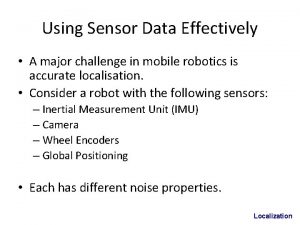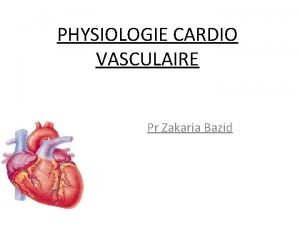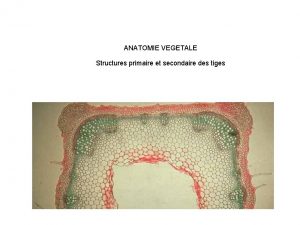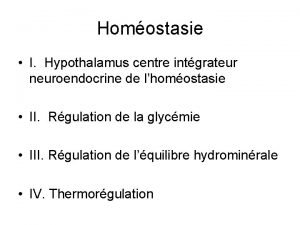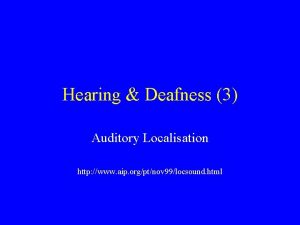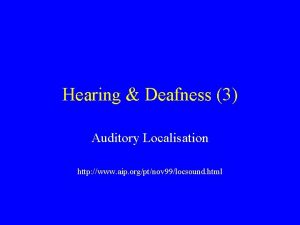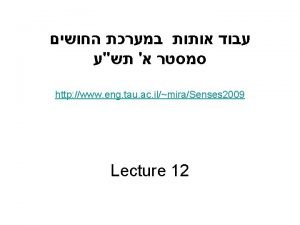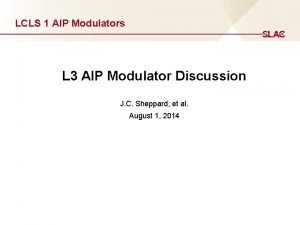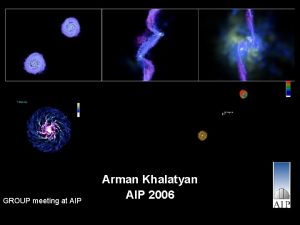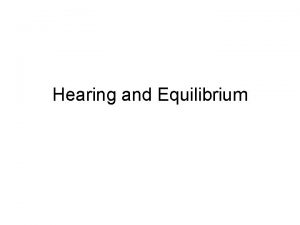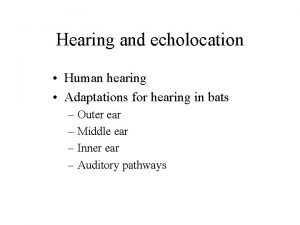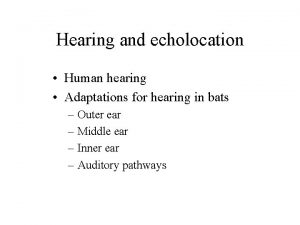Hearing Deafness 3 Auditory Localisation http www aip





























- Slides: 29

Hearing & Deafness (3) Auditory Localisation http: //www. aip. org/pt/nov 99/locsound. html

Demo class • 1 pm this Thursday 27 th Chichester LT • Going through Frequencies, Filters, Excitation patterns etc • Using Excel spreadsheet that you can download.

Localisation in 3 dimensions • Azimuth (left/right) (Arab. as-sumut, i. e. as = al the + sumut, pl of samt way) – Binaural cues: ITD and ILD • Median-plane (front, up, back, down) – Pinna-induced spectral cues – Head movements • Distance – Absolute level, excess IID (inverse-square law), spectral balance, reverberation

Interaural time-difference - ITD t. R t. L ITD = t R - t L Maximum c 0. 6 ms

Interaural Time Difference (ITD) From David Mc. Alpine Processed in Medial Superior Olive

The coincidence detection model of Jeffress (1948) is the widely accepted model for low-frequency sound localisation Right Ear Left Ear From David Mc. Alpine

Response 0 Interaural Time Difference Right Ear Left Ear From David Mc. Alpine

Response 0 Interaural Time Difference Right Ear Left Ear From David Mc. Alpine

Onset-time versus ongoing phase differences Natural sounds have both R L R

Onset-time Works for highand low-frequency sounds versus ongoing phase differences Does not work for high-frequency pure tones: - no phase locking above 4 k. Hz - phase ambiguity above 1. 5 k. Hz Natural sounds have both R LR

Phase-locking 1 0. 5 0 0 0. 2 0. 4 0. 6 0. 8 1 -0. 5 -1 Response to Low Frequency tones Inter-spike Intervals 2 periods 1 period time (t) Response to High Frequency tones > 5 k. Hz Random intervals time (t) nerve spike

Phase Ambiguity 500 Hz: period = 2 ms R L L lags by 1. 5 ms or R L leads by 0. 5 ms ? This particular case is not a problem since max ITD = 0. 6 ms But for frequencies above 1500 Hz it IS a problem

Phase Ambiguity 2000 Hz: period = 0. 5 ms R L L lags by 0. 3 ms or R L leads by 0. 2 ms ? Both possible times are less than the maximum ITD of 0. 6 ms

Anatomy of the auditory system

Interaural Level Difference (ILD) From David Mc. Alpine Processed in Lateral Superior Olive

ILD is greater for higher frequencies Interaural level differences calculated for a source in the horizontal plane. The source is at an azimuth q of 10° (green curve), 45° (red), or 90° (blue) relative to straight ahead. The calculations assume that the ears are at opposite poles of a rigid sphere.

Anatomy of the auditory system

Raleigh’s Duplex theory for pure tones • Low frequency pure tones (<1500 Hz) localised by interaural time differences • High frequency pure tones localised by intensity differences

Raleigh’s Duplex theory for pure tones (2) 1. Low frequency tones (<1500 Hz) localised by phase differences: • Very small interaural intensity difference for lowfrequency tones. • Phase locking present for low frequency tones (<4 k. Hz).

Raleigh’s Duplex theory for pure tones (2) 1. Low frequency tones (<1500 Hz) localised by phase differences: • Phase locking present for low frequency tones (<4 k. Hz). • Limited by phase ambiguity: Maximum ITD= 670 µs corresponding to a whole cycle at 1500 Hz (the upper limit for binaural phase sensitivity)

Phase ambiguity not a problem for complex high-frequency tones 1/200 th sec Freq 1800 1600 2000

Raleigh’s Duplex theory for pure tones (3) High (and close low) frequency tones localised by intensity differences • Shadow cast by head greater at high (20 d. B at 6 k. Hz) than low frequencies (3 d. B at 500 Hz) i. e. head acts as a lowpass filter. • For close sounds (<1. 5 m) the inverse square law gives intensity differences between the ears for all frequencies. These differences vary with azimuth independently of any head-shadow effect. Beyond 1. 5 m the difference in level between the ears due to this factor is less than 1 d. B.

Azimuth for complex sounds • Complex sounds contain both low and high frequencies • But the dominant azimuth information is the ITDs of the low frequencies

Precedence (or Haas) effect Titrate blue ITD vs red ITD to center the single sound Lots of red ITD needed to offset a little blue

Pinna notch

Head-Related Transfer Function: Median Plane

Anatomy of the auditory system

Distance More distant sounds are: • Quieter (inverse-square law) • More muffled (high frequencies don’t travel so well) • More reverberant (direct is quieter relative to reflected) For very close sounds, the difference in distance from the source to the two ears becomes significant -> excess IID from inverse-square law.

Binaural masking level difference Explain by simply Adding or subtracting the signals at the two ears (after adjusting their levels) (Durlach’s Equalisation and Cancellation model)
 Tuli icd 10
Tuli icd 10 La maison verte et bleue
La maison verte et bleue Localisation industry standards association
Localisation industry standards association Localisation
Localisation Localisation sensor data
Localisation sensor data Localisation of distributed data
Localisation of distributed data Danemark localisation
Danemark localisation Philippe choler
Philippe choler Christophe phillips
Christophe phillips Tissu nodal localisation
Tissu nodal localisation Ecg localisation of mi
Ecg localisation of mi Tissus nodal
Tissus nodal Phéllogène
Phéllogène Localisation absolue et relative
Localisation absolue et relative Polygone de willis localisation
Polygone de willis localisation Localisation gps
Localisation gps Localisation
Localisation Osmorécepteurs localisation
Osmorécepteurs localisation Cms localisation
Cms localisation Airport improvement program aip
Airport improvement program aip Aip modlin
Aip modlin Aip eurocontrol
Aip eurocontrol Aip animal
Aip animal Aip cuatro vientos
Aip cuatro vientos Aip
Aip Belarus aip
Belarus aip Faa aip handbook
Faa aip handbook Aip cabo verde
Aip cabo verde Aip backup
Aip backup American institute of physics style manual
American institute of physics style manual




